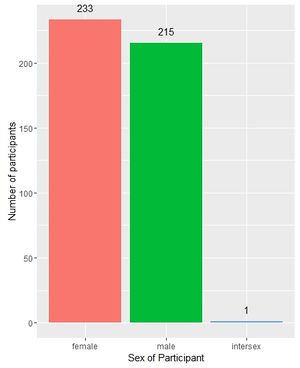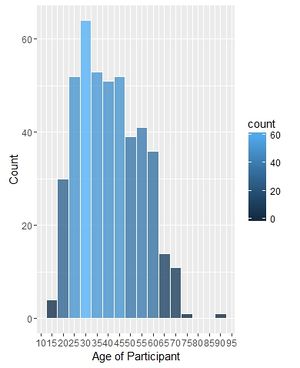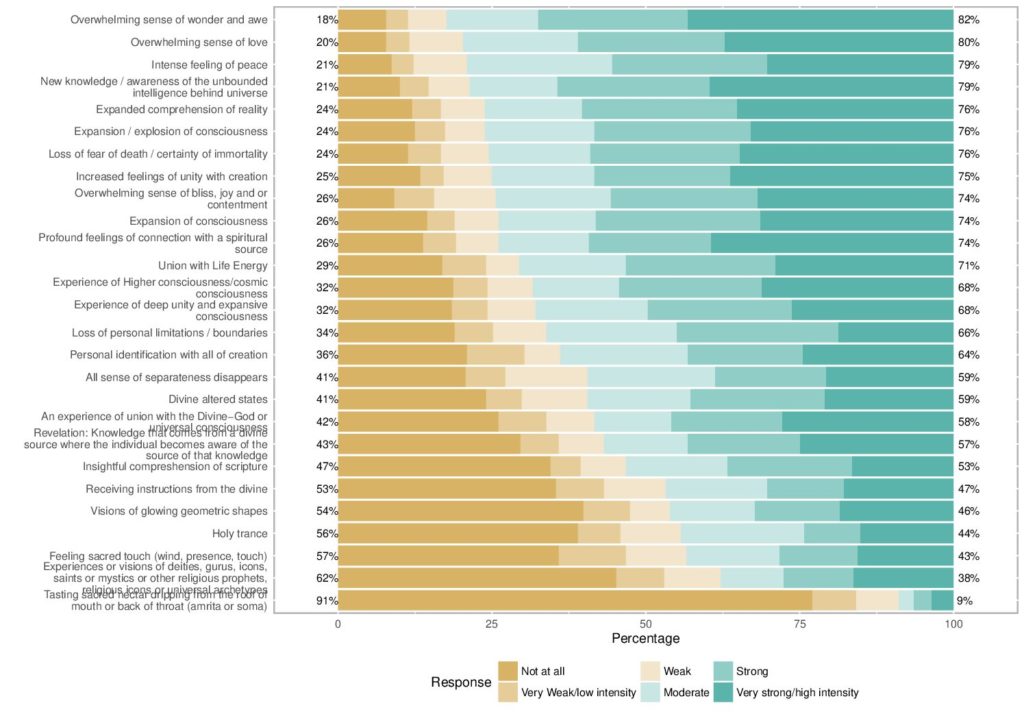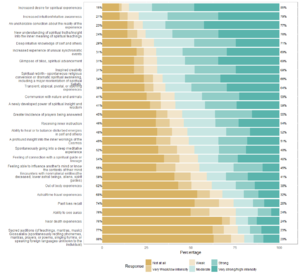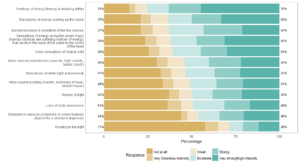Kundalini Experimental Project Overview
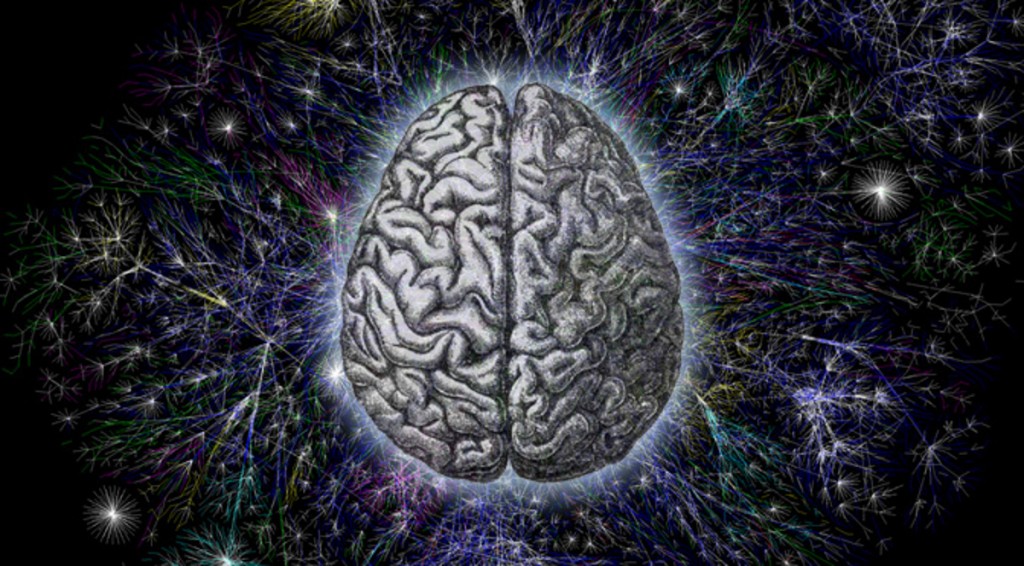
Preface
kundalini (ku̇n-də-ˈlē-nē) n. 1. The biological basis of all forms of spiritual experience, religion, genius, and higher consciousness. 2. The evolutionary energy residing in the human body.
The phenomena of religion, spirituality, and mystical or transcendental experience have long been shrouded in mystery. From a scientific point of view, little is known about the biological or evolutionary implications of the religious instinct which has dominated the landscape of human life for at least the past 5,000 years.
Over the past 200 years, works by luminaries such as Richard Maurice Bucke and Gopi Krishna have opened up new avenues of scientific research to empirically demonstrate the existence of a super-intelligent evolutionary mechanism within the body, termed “Kundalini” in the ancient Indian tradition.
A scientific hypothesis and set of empirical research methods have been developed to allow even the most skeptical scientists to validate the existence and operation of Kundalini within the human body. The hypothesis states that Kundalini is the biological basis of religion, genius, and insanity, and can be voluntarily awakened to accelerated activity. In its awakened state, it is possible for the brain to achieve new levels of heightened activity and accelerated evolution. Finally, if this process of evolution is allowed to proceed unhindered, it is possible for individuals to arrive at the next phase of human evolution, historically labelled as Enlightenment, Samadhi, Cosmic Consciousness, Christ Consciousness, etc. The scientific validation of a predetermined evolutionary process, guided by a higher intelligence, is the ultimate goal of our research.
Kundalini’s biological and empirically verifiable characteristics set it apart from all other forms of supernatural phenomena, justifying it as the primary focus of the Emerging Sciences Foundation. There are many valuable resources available about our specific approach, including important books and online learning materials, available on the Institute for Consciousness Research website. We encourage you to resist the urge of mental lethargy, bias, and hubris, now rampant in modern society, and join us on the same voyage of discovery which has been the preoccupation of the most enlightened cultures of antiquity.
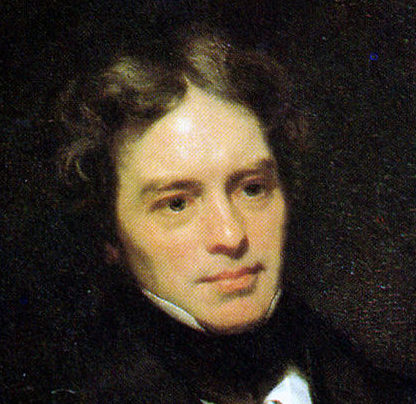
Overview
The Kundalini Experimental Project is a global research effort led by the Emerging Sciences Foundation to study the acquisition of Higher Consciousness and the evolutionary, biological mechanism behind it known as Kundalini. The end goal of the project is to voluntarily awaken this evolutionary mechanism in willing participants.
Kundalini is a phenomenon confirmed by thousands of years of recorded human observation. There is evidence that many ancient cultures understood the life factors responsible for a healthy awakening of Kundalini, resulting in the cultivation of genius. The Indians, Egyptians, and Mesoamericans all left behind written clues and artifacts chronicling their insights and observations of this phenomenon. Kundalini is not the “Kundalini Yoga” found in popular culture — it represents the biological basis of all spiritual experiences and, we believe, the force driving the evolution of humanity.
Physical and psychological manifestations of Kundalini vary depending on constitution, heredity, environment, etc. The Kundalini mechanism is theorized to exist as a super-intelligence working within the human body. Its purpose is to continue the perfection of the brain and uplift humankind to the next higher dimension of consciousness.
One of the goals this process is to bring a person in tune with hidden psychospiritual laws which underpin this evolution of the brain. These laws could also be called moral laws. Kundalini’s evolutionary biological effects make it an extremely important area of study, and supports the case for a large-scale, rigorous, and empirical investigation into the phenomenon. Understanding Kundalini is extremely important for the safety and survival of the species past the Nuclear Age.
The Kundalini Experimental Project is hosted on the Brilliano platform.
Research Approach
- Surveys
- Historical Research / Data Gathering
- Predictive Modeling
- Experimentation of methods to awaken and/or stabilize Kundalini on volunteer subjects
Surveys
- The Spiritual Experience Survey, released in December 2014, measures experiences such as energy sensations, unusual sensory perceptions, mystical experiences and spiritual practices as well as demographic characteristics. People from around the world have completed this survey, many reporting significant Kundalini experiences. The survey is administered via a social network application called Brilliano which also provides provides feedback to survey participants along with a spiritual practices tracker.
- The Personal Background Survey, released in October 2017, measures personal information such as lifestyle, beliefs, environmental and hereditary factors that could have a positive impact on the Kundalini awakening process.
The Kundalini Profile Survey
The Kundnalini Profile Survey measures the intensity levels of various types of psychological and physical experiences that might be related to Kundalini. All analysis techniques and source code is made freely available to the public as part of the Kundalini Discover project on GitHub.
Survey question groups:
- Mystical experiences
- Spiritual experiences
- Psychophysiological experiences
- Psychic experiences
- Talents and altruistic tendencies
- Physical effects
- Psychological effects
The Personal Background Survey
Map personal conditions, both inner and outer, that could be related to Kundalini experiences, e.g., diet, exercise, heredity, etc.
Survey question groups:
- Personal Background
- Heredity
- Spiritual Practices
- Personal Evolution
- Stressors and Traumas and Medical History
- Environmental Factors
- E.g., politics and social order
Analysis Goals
The Kundalini Profile Survey was created to document the types of spiritual experiences people are having, and associated physical and psychological experiences.
Analysis on the Kundalini Profile Survey has a few basic goals:
- Discover groupings of Kundalini experiences that occur together.
- Explore the relationship between different experience types and other physical and psychological experiences.
- Create an empirical, data-driven way of classifying a person’s spiritual experiences.
- Lay the groundwork for future experimentation on Kundalini by providing important measures that can be used to track progress. Future research will focus on potential ways to enhance or accelerate the Kundalini process. Kundalini is seen as the biological basis of all spiritual experiences.
Summary Information
Age and Sex
There has been broadly an equal participation from men and women, although there were slightly more women who took part. People of all ages have taken part in the survey with the majority of respondants being around the age of 30.
Sex of Survey Participants |
Age of Survey Participants |
Core Experience Summary
The survey contains a list of 66 “core experience” questions describing classical Kundalini awakening indicators. The list was derived from previous surveys and existing literature, and respondents reported the strength of their experiences along a 5-point likert scale.
The survey contains three categories of experiences:
- Mystical indicators are those that typically transcend the normal bounds of human experience.
- Spiritual indicators are those that, although they may have sublime characteristics, might not be as radical as mystical experiences.
- Psychophysiological indicators are those that affect the body and mind through some not yet understood connecting medium.
In the data, these are represented as the mystical, spiritual, and psyphys (psychophysiolocical) question categories. In general, the data shows a very common occurrence of powerful, transformative experiences among respondents. Prevalent experiences in each category include:
- Mystical experiencies associated with the perception of unity and consciousness.
- Spiritual indicators associated with wisdom and intuition.
- Psychophysiolocal experiences associated with energy vibrating or moving in the body.
Mystical likert questions summary. Access PDF. |
Spiritual likert questions summary. Access PDF. |
Psychophysiological likert questions summary. Access PDF. |
Primary Experience Categories Factor Analysis
Factor analysis was conducted on the 66 primary experience questions. Factor analysis is a technique of identifying groups of correlated variables that correspond to latent categories of experiences. The mystical, spiritual, and psychophysiological question categories were analyzed. The number of factors to be determined per category was determined using an empirical technique known as parallel analysis. Principal Axis Factoring with Promax rotation was performed, a technique commonly used for this type of psychological data.
One key observation during this process was the prominence of a single factor, labeled “Higher Consciousness,” which accounted for a very large portion of explained variance in the data. To illustrate this point, all 66 questions were used in the following scree plot, in which Higher Consciousness is shown as the first factor:
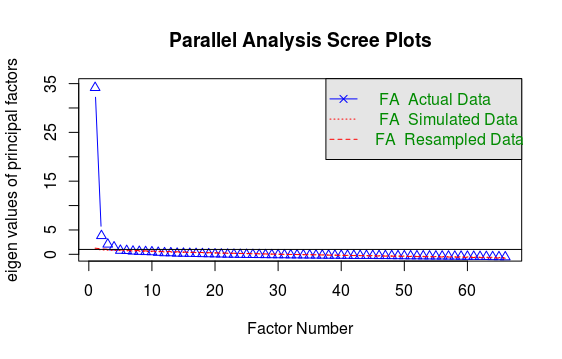
According to the Kundalini Hypothesis, Higher Consciousness is the goal of the Kundalini biological mechanism, and all other manifestations of Kundalini are secondary effects. In our analysis, Higher Consciousness was characterized by:
- The direct perception of consciousness.
- Unity and the personal identification with all of creation
Factor analysis yielded the resulting factors in each major experience category. The questions listed below have a factor loading > ~0.6. This threshold was selected for interpretability of the data:
Mystical Question Factors
| Higher Consciousness | Ecstacy | Grace Experiences |
|---|---|---|
| Experience of Higher consciousness/cosmic consciousness | Intense feeling of peace | Tasting sacred nectar dripping from the roof of mouth or back of throat (amrita or soma) |
| Expansion of consciousness | Overwhelming sense of love | Experiences or visions of deities, gurus, icons, saints or mystics or other religious prophets, religious icons or universal archetypes |
| Revelation: Knowledge that comes from a divine source where the individual becomes aware of the source of that knowledge | Overwhelming sense of bliss, joy and or contentment | Receiving instructions from the divine |
| New knowledge / awareness of the unbounded intelligence behind universe | Overwhelming sense of wonder and awe | Feeling sacred touch (wind, presence, touch) |
| Personal identification with all of creation | Visions of glowing geometric shapes | |
| Expanded comprehension of reality | ||
| Experience of deep unity and expansive consciousness | ||
| Union with Life Energy | ||
| All sense of separateness disappears | ||
| An experience of union with the Divine-God or universal consciousness |
Spiritual Question Factors
| Rebirth | Intuition | Synchronicity | Out of Body | Aural |
|---|---|---|---|---|
| New understanding of spiritual truths/Insight into the inner meaning of spiritual teachings | Feeling of connection with a spiritual guide or lineage | Spontaneously going into a deep meditative experience | Out of body experiences | Sacred auditions (of teachings, mantras, music) |
| Spiritual rebirth – spontaneous religious conversion or dramatic spiritual awakening, including a major reorientation of spiritual beliefs. | Receiving inner instruction | Increased experience of unsual synchronistic events | Astral/time travel experiences | Glossalalia (spontaneously reciting phonemes, mantras, prayers, or poems, singing hymns, or speaking foreign languages unknown to the individual) |
| An unshakable conviction about the reality of the experience | Inspired creativity | Encounters with nonmaterial entities(the deceased, lower astral beings, aliens, spirit guides) | ||
| Transient, atypical, pivotal, or opening experiences |
Psychophysiological Question Factors
| Energy Sensations | Light |
|---|---|
| Feelings of energy flowing or vibrating within | Visions of light |
| Sensations of energy rushing up the spine | Floating in the light |
| Sensations of energy along the seven major chakras (chakras are spinning vortices of energy) that run from the base of the spine to the crown of the head | Sensations of white light or luminosity |
| Inner sensations of heat or cold | |
| Transient or unusual symptoms or some features atypical for a standard diagnosis |
Backlog
- Factor correlations and diagrams.
- ICLUST analysis and diagrams.
- Pairwise correlations
The Mystical Classification (M-Class) Model
The M-Class (mclass) or “mystical classification” is a way to classify survey participants into distinct groups. The purpose of the M-Class model is to understand the differences between distinct types of Kundalini experiences and to develop methods to awaken Kundalini and reach Higher Consciousness.
The M-Class model uses Latent Class Analysis (LCA), a special type of mixture model developed for polytomous data. Other forms of cluster analysis such as K-means are based on arbitrary Euclidean distances, whereas latent class analysis is probabilistic and based on maximum likelihood estimates, and is thus a more empirical approach to clustering.
From the factor analysis (see above), key variables were identified and used in the M-Class model to classify respondents into different groups. The variables used are listed below:
M-Class Model Variables
| Variable Name | Likert Question Text | Experience Type (from factor analysis) | Used as predictor variable? | Used as an indicator variable? |
|---|---|---|---|---|
| mystical4 | Intense feeling of peace | Ecstacy | Yes | |
| mystical5 | Overwhelming sense of love | Ecstacy | Yes | |
| mystical13 | All sense of separateness disappears | Union | Yes | |
| mystical22 | Expansion of consciousness | Consciousness | Yes | |
| mystical24 | Experience of Higher consciousness/cosmic consciousness | Consciousness | Yes | |
| mystical26 | Personal identification with all of creation | Union | Yes | |
| spiritual1 | Spiritual rebirth – spontaneous religious conversion or dramatic spiritual awakening, including a major reorientation of spiritual beliefs. | Rebirth | Yes | |
| spiritual2 | New understanding of spiritual truths/Insight into the inner meaning of spiritual teachings | Rebirth | Yes | |
| spiritual14 | Out of body experiences | OOB | Yes | |
| spiritual15 | Astral/time travel experiences | OOB | Yes | |
| spiritual17 | Receiving inner instruction | Intuition | Yes | |
| spiritual20 | Feeling of connection with a spiritual guide or lineage | Intuition | Yes | |
| psyphys3 | Sensations of energy rushing up the spine | Energy | Yes | |
| psyphys5 | Feelings of energy flowing or vibrating within | Energy | Yes | |
| psyphys11 | Visions of light | Light | Yes | |
| psyphys12 | Floating in the light | Light | Yes |
Based on this model specification, two classes of experiencers were identified using the lowest Bayesian information criterion (BIC) out of a trial of 2-10 classes. The two distinct groups of experiencers are:
- Class 1 (“Kundalini stirring or Kundalini inactive”) – These individuals were either symptomatic, or had very few symptoms of a Kundalini awakening. The group comprised 49% of respondents.
- Class 2 (“Kundalini active”) – Kundalini active respondents. These individuals generally had strong indications of Higher Consciousness (probably at least one peak experience). Out of Body and Light sensations occurred less frequently, but still more often than in the Class 1 group. The group comprised a 51% of respondents, which is representative only of the people filling out the survey, rather than the general population. The percentage of people with these types of experiences within the general population is unknown and would be a desirable data point.
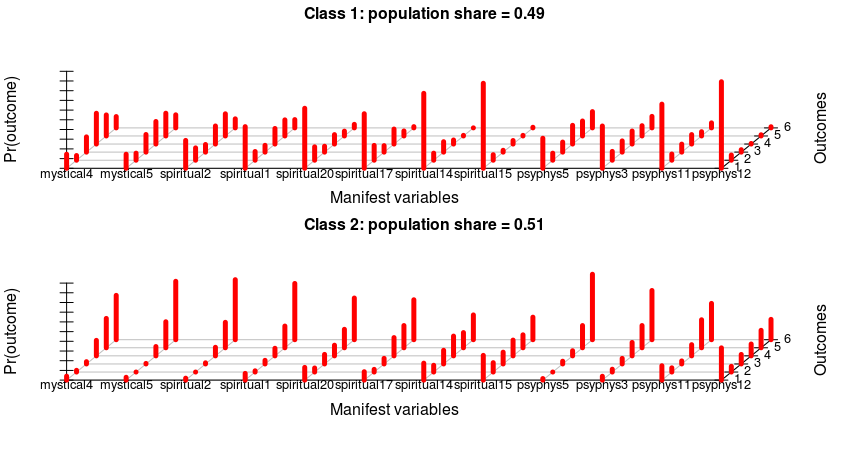
The M-Class is not a static model, but one that will be refined based on multiple criteria, including confirmatory analysis, interpretability, and experimental value.
M-Class Profiles
This research assumes that people falling under different M-Class’s will have different characteristics, behaviors, etc. Profiling means to examine each M-Class group and determine what these attributes are. Profiling of the M-Class model was first conducted using decision trees. Decision trees are a machine learning algorithm which looks at an outcome variable, in this case the mclass variable, and determines the best way to predict that outcome (or set of outcomes) based on the values of a number of predictor variables. The output is provided in the form of a tree plot. More information about how to interpret the tree plots used in our analysis can be found here (external PDF).
Psychological Differences
A decision tree analysis was run on psychological indicators (psygrowth and psybliss). The question answered is “what are the major psychological differences between Class 1 and Class 2 groups (limited by the types of questions asked)?” Analysis of the decision tree revealed three variables that appear related to the psychological profile of both groups of participants. Class 2 was more likely to indicate the following as psychological attributes:
- Devotional focus (
psybliss13) - An interest in helping others, compassion for the suffering (
psygrowth10) - Deep compassion (
psygrowth30)
The pattern of experience is clear – a more devotional, compassionate frame of mind appears to play an important role in the Kundalini process. The decision trees used in this analysis are included below, with the variables above highlighted in red.
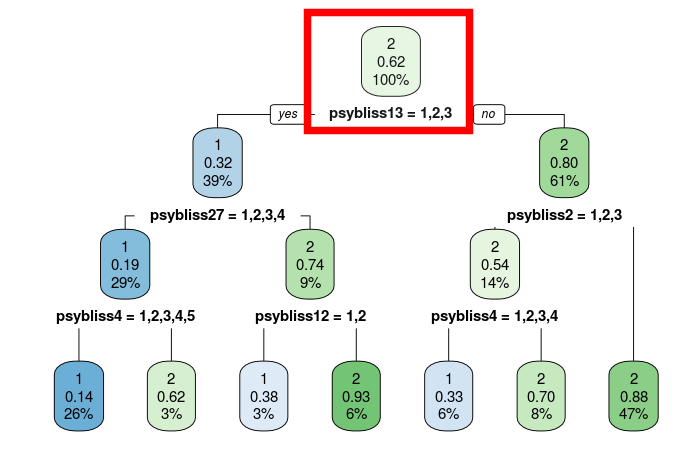
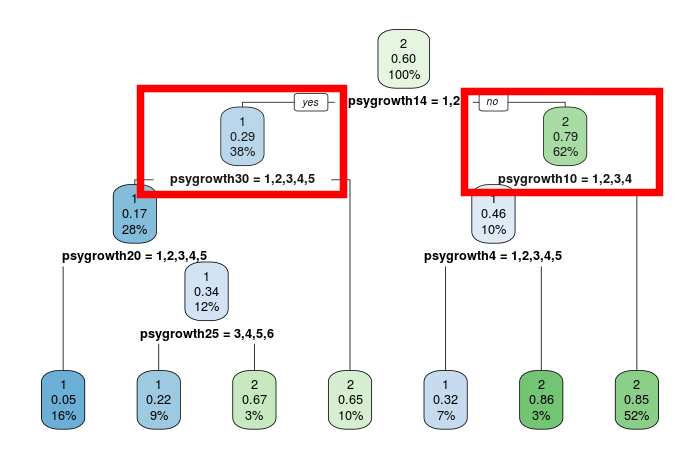
Backlog: Open text cross-validation
- Ensure consistency by analyzing open text responses.

